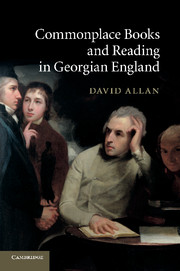Book contents
- Frontmatter
- Contents
- List of abbreviations
- Acknowledgements
- PROLEGOMENON
- PART I ORIGINS
- PART II FORM AND MATTER
- PART III READERS AND READING
- PART IV ANCIENT AND MODERN
- PART V TEXTS AND TASTES
- PART VI ANATOMISING THE SELF
- 14 The selfish narrator
- 15 Self-made news
- 16 Reading excursions: on being transported
- ENVOI
- Bibliography
- Index
16 - Reading excursions: on being transported
Published online by Cambridge University Press: 03 May 2011
- Frontmatter
- Contents
- List of abbreviations
- Acknowledgements
- PROLEGOMENON
- PART I ORIGINS
- PART II FORM AND MATTER
- PART III READERS AND READING
- PART IV ANCIENT AND MODERN
- PART V TEXTS AND TASTES
- PART VI ANATOMISING THE SELF
- 14 The selfish narrator
- 15 Self-made news
- 16 Reading excursions: on being transported
- ENVOI
- Bibliography
- Index
Summary
It is sufficient for my reader, if he has been a traveller himself, that with study and reflection hereupon he may be able to determine his own place and rank in the catalogue – it will be one step towards knowing himself; as it is great odds, but he retains some tincture and resemblance, of what he imbibed or carried out, the present hour.
Laurence Sterne, A Sentimental Journey (1768)… from these materials I formed a table of roads and distances reduced to our English measure; filled a folio common-place book with my collections and remarks on the geography of Italy; and inserted in my journal many long and learned notes on the insulae and populousness of Rome, the social war, the passage of the Alps by Hannibal, &c …
Edward Gibbon, Autobiography (1794)News and topical observations were not the only discourses relating to the world around them that struck a resounding chord with many readers. Indeed, travel, something that contemporary theorists of education insisted would extend people's knowledge both of themselves and of their wider environments, was another increasingly important focus for note-taking. It would be wrong, however, to think of this as a rejection of the conventional reading-oriented concerns of commonplacing. For as far back as the Odyssey, as Jean Viviès has pointed out, fictional tale-telling and the factual travel account have been ‘not clearly demarcated categories but poles which reveal a continuum’, a situation that commonplacing, so forgiving of generic ambiguity and cross-fertilisation, was advantageously placed to exploit.
- Type
- Chapter
- Information
- Commonplace Books and Reading in Georgian England , pp. 237 - 252Publisher: Cambridge University PressPrint publication year: 2010



